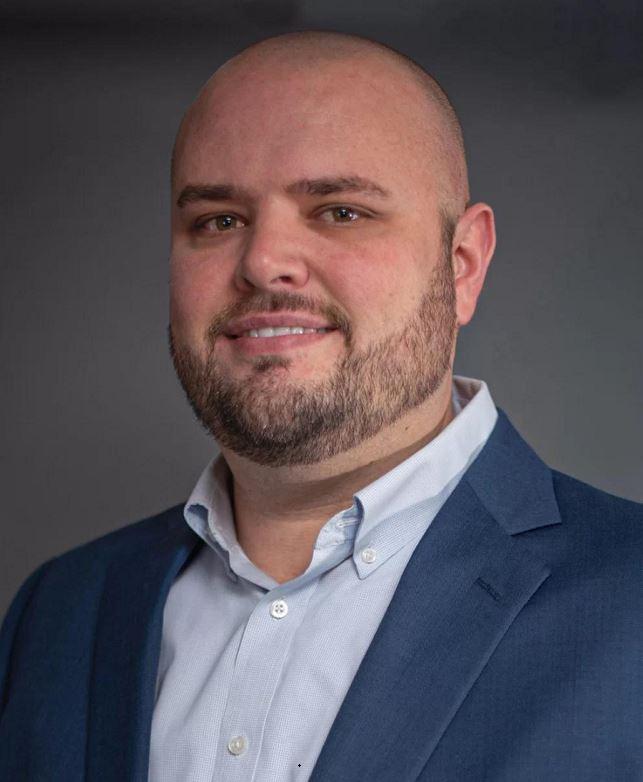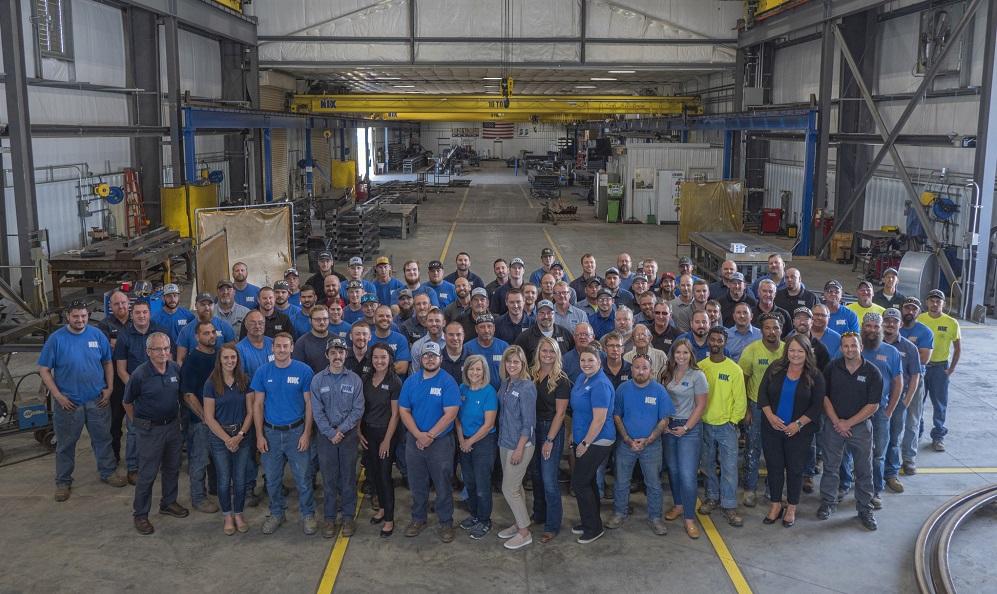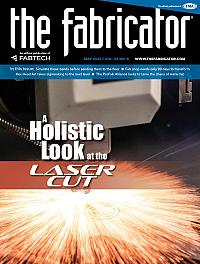Senior Editor
- FMA
- The Fabricator
- FABTECH
- Canadian Metalworking
Categories
- Additive Manufacturing
- Aluminum Welding
- Arc Welding
- Assembly and Joining
- Automation and Robotics
- Bending and Forming
- Consumables
- Cutting and Weld Prep
- Electric Vehicles
- En Español
- Finishing
- Hydroforming
- Laser Cutting
- Laser Welding
- Machining
- Manufacturing Software
- Materials Handling
- Metals/Materials
- Oxyfuel Cutting
- Plasma Cutting
- Power Tools
- Punching and Other Holemaking
- Roll Forming
- Safety
- Sawing
- Shearing
- Shop Management
- Testing and Measuring
- Tube and Pipe Fabrication
- Tube and Pipe Production
- Waterjet Cutting
Industry Directory
Webcasts
Podcasts
FAB 40
Advertise
Subscribe
Account Login
Search
Fabricator launches ProFab Alliance to provide shared resources for small shops
New industry group aims to help metal fab shops grow with united management system, philosophy
- By Tim Heston
- May 8, 2023
- Article
- Shop Management

Most metal fabrication shop owners and managers know all about chaos on the shop floor. The ProFab (Progressive Fabricator) Alliance would like to make chaos the exception, not the rule.
Adam Schmitt encourages customers to visit NIX any time. Employees at the Poseyville, Ind., plant have no need to tidy up before a big customer visits.
“I just tell people to walk through our shop. They won’t see anyone without safety glasses or smoking at their workstations. They’ll see swept floors and organized workspaces. And when visitors get within 10 ft. of anyone, our people stop what they’re doing and introduce themselves. When a customer visits, announced or unannounced, it’s exactly the same. That’s authentic. When customers walk through the door, they understand what NIX is.”
A decade ago, NIX had 15 employees. After years of growth, organically and through acquisition, the fab shop is now part of an organization that employs 150 people. Since the current owner took over in 2003, revenue has grown 100-fold. Schmitt attributed much of that growth to the company’s progressive management system. “Many can fabricate steel. It’s really about the culture, the knowledge, and the systems. That’s how the ProFab Alliance came about.”
Launched in 2022 with Schmitt as its managing director, the Progressive Fabricator (ProFab) Alliance is in a prototype phase, and about two dozen other fabricators have expressed interest. At FABTECH Atlanta held in November, Schmitt presented the concept: an alliance of various metal fabricators united by a shared management system and philosophy.
Better planning allows company leaders to keep work at work. They shouldn’t spend their careers juggling chaos and putting out fires. As Schmitt put it, “We want to set people up for growth and allow them to take back their life.”
Consulting, Networking, Purchasing
The ProFab Alliance operates as a subsidiary of Nix Companies Inc. (NCI), a corporate group that includes NIX (the original metal fabrication business) along with a marketing company (Captivated Content), a heavy vehicle repair operation, and a commercial real estate company.
“[The ProFab Alliance] falls into two buckets, strategic planning with executive coaching opportunities and [bucket No. 2] fabrication-specific management systems,” Schmitt said, adding that he envisions alliance members experiencing some purchasing benefits in addition to these two buckets. He also said that the alliance, at this writing still in the prototype phase, will launch in mid-2023. He added, though, that the management philosophy and system behind ProFab’s strategic planning and management systems are very much established.
About Profits, Training, and Accountability
ProFab Alliance’s roots go back to a strategic plan NCI managers developed in 2017. “At that point, we created a five-year plan,” Schmitt said. “Our owner and president, Matthew Nix, had been thinking about our growth potential for a while. Six of us were sitting around the conference room table when he said, ‘I just want to throw this out there. We have the opportunity to grow 100 times in 20 years.’” That is, 2023 revenue could be 100 times larger than it was in 2003, the year Matthew started working for Nix. “So, that’s when our operating plan came out, and we rolled out that 100x logo to all employees. They knew what it meant.”
What happened next reflected a challenge many fab shops face. NCI grew organically and through acquisition. Between 2017 and 2020, NIX acquired a structural operation, a heavy fabrication company, and a machine shop. After all this, the fabricator hit its growth goal a year early, in 2022. It was a time of celebration, for sure, but also a time for reflection.
As Schmitt recalled, “After we achieved 100x, we began to transition from a high-growth local company to a mature, mid-market organization. We had been in high growth mode for five years. Grow, grow, grow. If we made a mistake, that was fine. Let’s keep growing. Last year, though, we knew we needed to slow down. Let’s put some new processes in place, and let’s get rid of some old ones.”

As president of the newly formed ProFab Alliance, Adam Schmitt and his team have plans to build the business that offers networking, consulting, and purchasing services.
Cleaning House
From this experience came NCI’s management and planning system that will become core elements of the ProFab Alliance. The system aims to create a metal fabricator where people want to work, a place where achieving a healthy work-life balance isn’t just an aspiration.
The system involves instilling a culture of safety and professionalism. Imagine an employee who’s new to manufacturing. He didn’t grow up in a manufacturing family; in fact, he’s never been on any factory floor in his life. He sees old machines without safeguards, poorly lit workstations, metal parts stashed everywhere—on the floor, in racks. People smoke while operating machines. Hot, uncirculated air hangs over workstations. It’s not a workplace to brag about. If the shop produces any marketing material, photographers need to get in close and catch the arcs and sparks. Wide shots aren’t very complimentary and, more than likely, reveal safety violations. Managers might say they want to grow and create an employer of choice, but their actions (or lack thereof) say otherwise.
Schmitt is honest, too. A decade ago, NIX’s shop floor wasn’t what it is today. Some smoked at their workstations. Others didn’t wear safety glasses when they should have (“I’m guilty of this too,” Schmitt said). The floor wasn’t as clean as it should have been.
But that’s changed over the years. “It took us a long time,” Schmitt said. “You can’t force-feed everything, because if you do, it’s not authentic. It has to come from the team member level.”
The 5S methodology remains one of the most popular entry points to lean manufacturing, and shop managers have tried all sorts of tactics to instill and sustain a clean shop. Although critical for success, audits and other top-down measures can go only so far. Forcing change just isn’t sustainable.
First, cleaning shop can’t be a Band-Aid covering up a dysfunctional shop culture. This is where strategic planning comes into play. According to a presentation Schmitt made at FABTECH, the ideal strategic plan should enhance culture by (1) creating more workforce engagement; (2) fostering transparent communication at all levels; (3) increasing leadership capacity; (4) generating trust and enthusiasm at all levels; (5) fostering broad ownership with accountability; and (6) promoting teamwork in a focused way.
These are lofty goals, for sure, but without action, they lack authenticity and honesty—and being honest starts with the numbers. “It’s about being transparent,” Schmitt said. “At NIX, we talk about our financials on a regular basis with all team members. With everyone, we go down to the gross profit level. With managers, we talk about net income or EBITDA.”
Another set of numbers involves, of course, fair wages and financial incentives. But it’s not all about money. Let’s be honest, if employees’ sole purpose is to make more and more money, they probably wouldn’t choose a career in metal fabrication.
Here, the ProFab Alliance borrows from Jim Collins, author of “Good to Great.” During his FABTECH presentation, Schmitt asked leaders to identify their core focus, passion, potential for excellence (being the best), and their economic engine (the profits that support a company’s passion and potential). The confluence of all three reveals where a company can excel in the long run.
Next comes a company’s vision. It might be aspirational, and it might never be achieved fully, but a vision statement acts as a fabricator’s North Star. Schmitt gave several iconic examples during his presentation at FABTECH. Walt Disney’s vision is “to make people happy.” IKEA’s is “to create a better everyday life.” 3M’s is “to solve unsolved problems innovatively.”

A decade ago, NIX employed 10 people. Today, 150 people work for NIX Companies’ multiple facilities.
As Schmitt described, “Is that vision authentic, something true to what the organization is all about, not merely words on paper that sound nice? Would this vision be greeted with enthusiasm rather than cynicism by a broad base of people in the organization? When telling your children or other loved ones what you do for a living, would you feel proud in describing your work in terms of this vision?”
Schmitt conceded that all this might sound foreign, esoteric, and not particularly useful, especially in the ever pragmatic, cut-the-B.S. fabrication business. He added, though, that developing these elements for shop culture is a foundational step that sets a fabricator apart. After all, most fab shops don’t work with proprietary technology. Nothing can really stop competitors from buying similar or identical equipment, be it a laser cutting system, a punch, a brake, or a welding power source. The concepts of lean manufacturing—5S, quick changeover, single-piece flow, kanban squares to limit work-in-process—aren’t secrets either.
What’s missing, Schmitt said, are management systems to attract and retain the right people who can help a small shop grow. The lack of good systems is why some fabricators introduce safety and 5S programs, clean up the shop floor, improve lighting and air circulation, control work in process, shorten changeover times, and start documenting processes and amping up training and knowledge dissemination—only to find chaos returns when things get busy.Metal fabrication is a team effort. A star welder might lay down a near-perfect bead that requires little to no grinding. But if that piece is assembled or packaged incorrectly and arrives at the customer as a defective part, what good is that perfect weld? Teamwork is what makes metal fabrication so rewarding, but it’s also why finding and developing that team remains so critical.
It starts with the most basic elements, including job descriptions, roles, responsibilities, and expectations. So many small shops operate in that say-no-to-bureaucracy spirit, and, in bootstrapping fashion, do what they can to muscle jobs through. But as revenues and headcounts grow, confusion and challenges arise. An org chart needs to be solidified; responsibilities need to be formalized. This doesn’t mean a shop throws cross-training and flexibility out the window. But job descriptions and documented expectations do set up a matrix of responsibility and accountability.
This dovetails into another critical element that the ProFab Alliance promotes: closed-loop management. “Many put strategic plans in place, and they fizzle out,” Schmitt said, adding that the main reason they do is the lack of follow up: Was an initiative executed and sustained? “[Closed-loop management] allows managers to stop managing by walking around.”
Going to gemba (shop floor walks, seeing where the work takes place) is a healthy practice; serendipitous discovery of waste can be a powerful thing. But it’s not a management strategy.
Closed-loop management needn’t always deal with complex issues, either. Schmitt described one recent change at NIX that dealt with how delivery trucks were routed through the fab shop’s laydown yard. The initiative involved installing signage and informing drivers where to deliver certain materials. “So, how is this going to be sustained? Well, on a monthly basis, we walk the laydown yard and monitor those deliveries to ensure everything is in its designated space,” Schmitt explained. “It’s that simple.”
Beyond this, NIX holds a weekly leadership meeting to review metrics. “Some are actual, and some are estimated,” Schmitt said. “Regardless, the metrics give us a snapshot of what the business looks like. Essentially, [closed-loop] management is about how information disseminates from the executive team to the shop floor, then from the shop floor back to the executive team.”
About Time
In recent weeks, NIX has begun finalizing what it calls its Path Program, an initiative that delves into developing career paths for employees. As Schmitt described it, “It’s all about asking, ‘Hey, what do you want to do in life?’ You might be a welder, but you might aspire to be an accountant. We create a road map for them to get there.”
The program will build from NIX’s existing training programs, one for those aspiring to become company leaders and another (just as significant) for those who focus on the craft of metal fabrication. “We have huge training boards out in the shops,” Schmitt said, adding that each create matrices involving people, machines, processes, and technologies. Red signifies someone’s a novice at a particular task, yellow an apprentice, green a master. “We have written manuals on what it takes to move from a red to yellow to green, including the required time, effort, and experience.”
Schmitt clarified that the ProFab Alliance won’t spread identical management programs across different fabricators, be it about training, strategizing, or anything else. Every shop is different, and what works for NIX might not work somewhere else. The goal is for shop leaders to stop chasing the eight ball, focus on what’s next rather than what’s happening now, and institute a business structure that’s scalable.
“It’s all about efficiency,” he said. “I know all about arriving at 5 in the morning and leaving at 7 at night. Fabricators need to get to a critical mass to start hiring support staff, so that leaders don’t have to wear so many hats. We want them to go home at the end of the day and have dinner with their family. We want people to live the lives they want to live.”
About the Author

Tim Heston
2135 Point Blvd
Elgin, IL 60123
815-381-1314
Tim Heston, The Fabricator's senior editor, has covered the metal fabrication industry since 1998, starting his career at the American Welding Society's Welding Journal. Since then he has covered the full range of metal fabrication processes, from stamping, bending, and cutting to grinding and polishing. He joined The Fabricator's staff in October 2007.
subscribe now

The Fabricator is North America's leading magazine for the metal forming and fabricating industry. The magazine delivers the news, technical articles, and case histories that enable fabricators to do their jobs more efficiently. The Fabricator has served the industry since 1970.
start your free subscription- Stay connected from anywhere

Easily access valuable industry resources now with full access to the digital edition of The Fabricator.

Easily access valuable industry resources now with full access to the digital edition of The Welder.

Easily access valuable industry resources now with full access to the digital edition of The Tube and Pipe Journal.
- Podcasting
- Podcast:
- The Fabricator Podcast
- Published:
- 04/16/2024
- Running Time:
- 63:29
In this episode of The Fabricator Podcast, Caleb Chamberlain, co-founder and CEO of OSH Cut, discusses his company’s...
- Industry Events
16th Annual Safety Conference
- April 30 - May 1, 2024
- Elgin,
Pipe and Tube Conference
- May 21 - 22, 2024
- Omaha, NE
World-Class Roll Forming Workshop
- June 5 - 6, 2024
- Louisville, KY
Advanced Laser Application Workshop
- June 25 - 27, 2024
- Novi, MI































